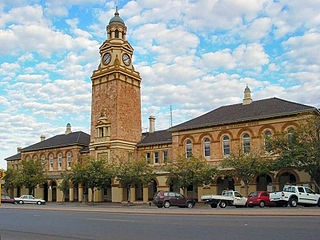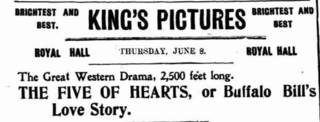Related Research Articles

Kalgoorlie is a city in the Goldfields–Esperance region of Western Australia, located 595 km (370 mi) east-northeast of Perth at the end of the Great Eastern Highway. It is sometimes referred to as Kalgoorlie–Boulder, as the surrounding urban area includes the historic townsite of Boulder and the local government area is the City of Kalgoorlie–Boulder.

William John "Nipper" Truscott Jr. was an Australian sportsman. He played over 300 games of Australian rules football for Mines Rovers in the Goldfields Football League (GFL) and East Fremantle in the West Australian Football League, and represented Western Australia at football, cricket and lawn bowls. He was inducted into the Sport Australia Hall of Fame in 1985 and the Australian Football Hall of Fame in 1996.

John F. Gavin was a pioneer Australian film actor and director, one of the early filmmakers of the 1910s. He is best known for making films about bushrangers such as Captain Thunderbolt, Captain Moonlite, Ben Hall and Frank Gardiner. Known informally as 'Jack', Gavin worked in collaboration with his wife Agnes, who scripted many of his films.
Ben Hall and his Gang is a 1911 Australian film about the bushranger Ben Hall, played by John Gavin, who also directed. It is considered a lost film.
Agnes Gavin (1872–1947), was an Australian actor and screenwriter in the silent film era. She worked in collaboration with her husband John Gavin throughout her career. She wrote the majority of his films and was arguably the first specialist screenwriter in the history of the Australian film industry. In newspapers she was advertised as the "well known picture dramatizer" and was praised for creating "cleverly constructed stories". Many of her films are considered lost.
Keane of Kalgoorlie, or a Story of the Sydney Cup is a 1911 Australian silent film set in the racing and gambling circles of Sydney, based on a popular play by Edward William O'Sullivan and Arthur Wright, adapted from the novel by Wright.

His Convict Bride is a 1918 Australian silent film from the team of John and Agnes Gavin. It was a convict-era melodrama.
Robbery Under Arms is a 1907 Australian silent western/drama film based on the 1888 novel by Rolf Boldrewood about two brothers and their relationship with the bushranger Captain Starlight. It was the first film version of the novel and the third Australian feature ever made.

The Loyal Rebel is a 1915 Australian silent film directed by Alfred Rolfe set against the background of the Eureka Rebellion.

Bushranger's Ransom, or A Ride for Life was an Australian silent film produced by Pathé Frères' in 1911, their first motion picture production in Australia after establishing a branch office in Sydney in April 1910. It was adapted from a stage play first performed in 1907 by E. I. Cole's Bohemian Dramatic Company.

The Five of Hearts, or Buffalo Bill's Love Story is a 1911 Australian film from Edward Irham Cole based on a stage play about Buffalo Bill which Cole had performed extensively. It is also known as A Maiden's Distress or Buffalo Bill. It was reportedly the longest of Cole's films.
Gambler's Gold is a 1911 Australian film based on the 1911 novel by Arthur Wright. It is considered a lost film.
In the Last Stride is a 1916 Australian silent film directed by Martyn Keith based on the 1914 popular action novel by Arthur Wright. The film's star, Dave Smith, was a champion heavyweight boxer who had fought Les Darcy. There was also an appearance from boxer Les O'Donnell.
Arthur Wright was an Australian writer best known for his novels set against a background of the sporting world, particularly horseracing, which meant he was often compared during his lifetime to Nat Gould. In his lifetime he was called "Australia's most prolific novelist".

Stanley Sadler Crick was an Australian film producer, distributor and politician. He joined the Melbourne office of Pathe Freres and became manager of the Sydney branch in 1909. He went into production, first in partnership with Herbert Finlay then helping establish the Australian Photo-Play Company.
Herbert Finlay was an Australian producer, photographer and exhibitor. He initially worked in films as a photographer and exhibitor of news items in Melbourne in the late 1890s. He helped tour The Story of the Kelly Gang (1907) and joined Pathe in 1910 to produce the Sydney edition of their newsreel. He went into producing with Stanley Crick and ran the camera department for the Australian Photo-Play Company. He was seriously injured in a film fire and became a travelling exhibitor.
The Australian Photo-Play Company was a short-lived but highly productive Australian film production company which operated from 1911 to 1912.

Rugby union in Western Australia describes the sport of rugby union being played and watched in the state of Western Australia. First introduced some time in 1868 it was the most popular football code until it was overtaken by Australian rules there in 1885. After a period of decline and recess between 1905 and 1927 it grew throughout the 20th century. The governing body is the Western Australia Rugby Union (RugbyWA).
A Sport from Hollowlog Flat is a 1915 novel by Arthur Wright. It consisted of a series of short stories he had published previously for various magazines.
The King of the Road is a 1900 Australian play performed by Edward Irham Cole performed by Cole's Bohemian Drama Company about the bushranger Ben Hall.
References
- ↑ "KEANE OF KALGOORLIE". The Referee . Sydney: National Library of Australia. 31 October 1906. p. 6. Retrieved 27 September 2014.
- ↑ "To Pana's Page on Passing and Past Shows". The Referee . Sydney: National Library of Australia. 1 July 1931. p. 24. Retrieved 13 September 2014.
- ↑ "A MODEST NOVELIST". The Barrier Miner . Broken Hill, NSW: National Library of Australia. 23 February 1914. p. 7. Retrieved 27 September 2014.
- ↑ "VILLAINY UNMASKED". The Advertiser . Adelaide: National Library of Australia. 7 December 1907. p. 15. Retrieved 27 September 2014.
- ↑ "KEANE OF KALGOORLIE". The Referee . Sydney: National Library of Australia. 15 April 1908. p. 11. Retrieved 27 September 2014.
- ↑ "THE AUTHORSHIP OF "KEANE OF KALGOORLIE."". The Sunday Times . Sydney: National Library of Australia. 22 November 1908. p. 2. Retrieved 27 September 2014.
- ↑ "THE STRUTTER'S PAGE". The Newsletter: an Australian Paper for Australian People . Sydney: National Library of Australia. 14 March 1908. p. 3. Retrieved 27 September 2014.
- ↑ "THE HAYMARKET HIPPODROME". The Sydney Morning Herald . National Library of Australia. 18 April 1908. p. 14. Retrieved 27 September 2014.
- ↑ "Australian Moving Pictures. An Industry Which Has Failed to Grow Up. Some Reminiscences.", Everyones., 6 (357 (5 January 1927)), Sydney: Everyones Ltd, nla.obj-576826185, retrieved 26 February 2024– via Trove
- ↑ "HAYMARKET HIPPODROME". The Sunday Times . Sydney: National Library of Australia. 19 April 1908. p. 2. Retrieved 27 September 2014.
- ↑ "POLITICIAN AND PLAYWRIGHT". The Sydney Morning Herald . National Library of Australia. 20 April 1908. p. 3. Retrieved 27 September 2014.
- ↑ ""KEANE OF KALGOORLIE."". The Evening News . Sydney: National Library of Australia. 20 April 1908. p. 8. Retrieved 27 September 2014.
- ↑ "HAYMARKET HIPPODROME". The Sunday Times . Sydney: National Library of Australia. 26 April 1908. p. 2. Retrieved 27 September 2014.
- ↑ "NEW PLAY BY AN AUSTRALIAN AUTHOR". The Mail . Adelaide: National Library of Australia. 5 August 1916. p. 6. Retrieved 24 February 2012.
- ↑ "Advertising". Sunday Times . Perth: National Library of Australia. 28 December 1919. p. 8 Section: First Section. Retrieved 24 February 2012.